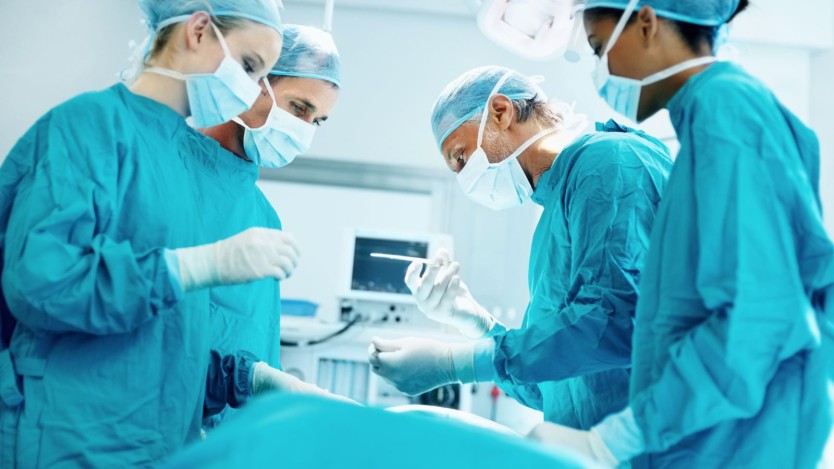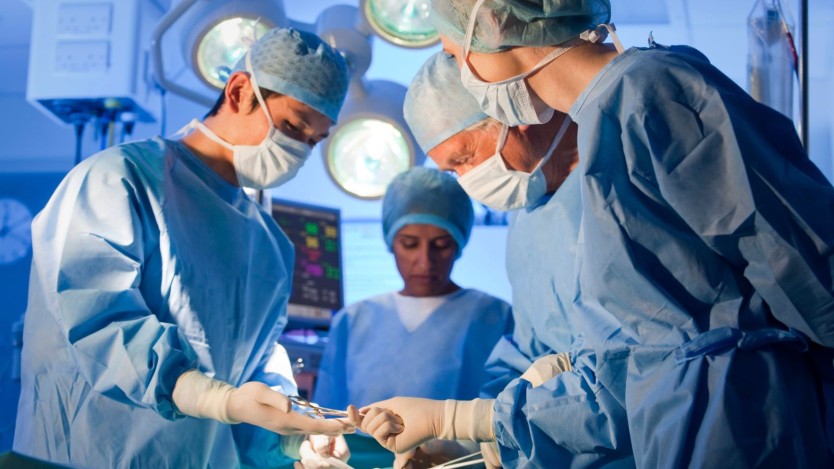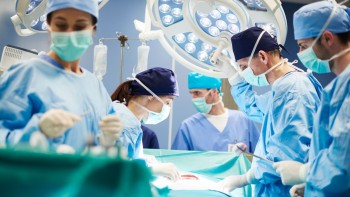Nasal polyps surgery: duration, cost and step by step

- What does nasal polyp surgery consist of?
- Nasal polyps surgery: step by step
- Preoperative of Nasal Polyp Surgery
- Postoperative of a nasal polyp surgery
- How long does nasal polyp surgery take?
- Cost of nasal polyp surgery
- Request a surgical assessment consultation with our specialists
- Nasal polyps are soft, painless growths that occur inside the nose.
- Nasal polyps can cause nasal congestion, total or partial loss of smell.
- In cases where nasal polyps cause serious problems, endoscopic sinus surgery is performed.
What does nasal polyp surgery consist of?
Nasal polyps are abnormal, soft, painless growths that develop inside the nose. They form in the lining of the nasal passages and sinuses. Nasal polyps are polypoid sinusitis but do not imply a cancerous characteristic. These formations, which look like grapes or gout, are usually caused by inflammation due to asthma, infection, allergies etc.
When these formations do not reach very large dimensions, i.e. their size is small, they do not usually cause any symptoms.
However, when the growths are larger, the agglomeration of these can clog the nasal passages and hinder certain functions of the olfactory system, such as reducing the ability to perceive odours or even making it difficult to breathe easily.

Do you need surgery to eliminate nasal polyps?
Request a free and immediate appointment with our specialists in Otorhinolaryngology
Although the creation of nasal polyps is more common in adults, the disease can affect any individual. As a result, there are various treatments available to treat and eliminate these growths. Thus, nasal polyposis can be treated with medication to help reduce or even eliminate the polyps, but sometimes endoscopic sinus surgery is necessary.

The nasal polyp operation is based on endoscopic nasosinusal surgery, which provides a very minimally invasive surgical method. In fact, it can be performed on an outpatient basis and you can return home the same day of the operation. Even so, Operarme includes one day of hospitalisation, as this is the most advisable.
In this surgery, the nostrils and paranasal sinuses are operated on in order to dissect the nasal wall and remove the obstructing tissue, in this case nasal polyps. The course of the mucosa is therefore automatically restored. This operation consists of making an opening in the drainage orifices, eliminating infections and cleaning the paranasal sinuses.
One of the reasons why endoscopic sinus surgery is performed is when sinusitis is chronic.
The appearance of nasal polyps contributes to the development of the disease and persistent inflammation and infection over time. Therefore, we will now discuss the reasons why nasal polyp surgery is required.
Nasal polyps surgery: step by step
Endoscopic sinus surgery becomes a necessary option when polyps or chronic nasal and sinus inflammation appear. This disease has a pharmacological treatment but when medications do not eliminate the abnormal growths, which cause nasal obstruction, nor reduce their size, it is necessary to intervene with endoscopic surgery.
When the size of nasal polyps is significant, it can cause blockages in the nasal passages. It can also cause blockages in the sinus drainage pathways, and the sufferer is much more likely to get a sinus infection more easily.
Nasal polyps can cause nasal congestion, total or partial loss of smell, diminished sense of taste, runny nose, headache, swelling and discomfort in the affected area and signs of constipation.
As mentioned in the previous paragraph, nasal polyps develop inside the nose, forming in the airways and sinuses. Therefore, with the appearance of these abnormal growths, the entire nasosinusal structure is affected.
We will now explain in detail which functions the disease limits us and which nasal and sinus structures are involved in endoscopic sinus surgery.

The nostrils are the cavities separated by the sagittal septum. They are located in the upper part of our mouth and have numerous functions. These are:
- To filter the air we breathe.
- To collect the impurities of the particles present in the air.
- To perceive and differentiate odours.
- To warm the air we inhale so that it does not reach our lungs cold.
On the other hand, the paranasal sinuses are four cavities located between the bones of the face and head. The function of the paranasal sinuses is to:
- Draining the mucous fluid inside them.
- To distribute the air we receive through the respiratory tract.
- Humidify the nose and contribute to its lubrication to keep it free of particles and bacteria.
Thus, when drugs do not resolve the disease and the area remains inflamed and infected and, therefore, the functions of our olfactory system remain limited, it is necessary to resort to endoscopic sinus surgery.
Therefore, the medical characteristics that define a patient requiring surgical intervention are as follows:
- Contracting sinusitis, regardless of the type of sinusitis. This disease occurs when there is an increase in bacteria in the paranasal sinuses and a virus or bacterial infection occurs. When sinusitis is acute, it can be treated with drugs, but if it is not resolved, it can lead to chronic sinusitis, making endoscopic sinus surgery necessary.
- Nasal polyposis involves abnormal growths of the internal nasal tissue or mucosa called nasal polyps. These, like other diseases, can be treated medically with inhalers and pills to reduce their size. However, as we have already mentioned, surgical intervention is a much more effective solution.
- Suffering episodes of epistaxis means suffering from blood leaks caused by ruptured blood vessels on the surface of the nasal cavity, leading to nosebleeds.
- With the appearance of nasal and sinus tumours, endoscopic nasosinusal surgery becomes the only effective option. The existence of these anomalies, whatever their type and regardless of the aerodigestive area in which they are located, requires surgical treatment for their total removal.
Once the causes of the disease have been made known and the surgical priority has been established for all of them, the way to proceed at Operarme is to request an appointment with our ENT specialist to assess your situation and thus proceed with a possible pre-operative procedure.

Do you need surgery to eliminate nasal polyps?
Request a free and immediate appointment with our specialists in Otorhinolaryngology
Preoperative of Nasal Polyp Surgery
After the consultation with the specialist, our team of consultants will contact you to ask you about the appointment in question and to arrange a date for the surgery.
The waiting time between the consultation and the operation will depend on the availability of the operating theatre and the duration of the preoperative period. This usually takes about 7 to 10 days.
The preoperative examination is performed as usual and consists of a series of tests, such as an electrocardiogram, blood tests and a chest x-ray. The latter will only be necessary when the doctor deems it appropriate. In addition, it is possible that our specialist may require a CT scan. In this case, please contact our patient care team to arrange the price and availability of the test.
- Electrocardiogram, to check your cardiovascular health.
- Blood tests, to check for any abnormalities or pathologies, such as infections that can delay surgery until they are under control.
- Chest x-ray. As mentioned above, this test is only performed if the specialist considers it necessary. It can be used to see if there is any infection in the trachea or if the trachea is aligned.
- Computed tomography of the bones (CT scan), to appreciate the anatomy of the paranasal sinuses, nasal cavities and possible anomalies caused by the disease.
After the preoperative, you will have an appointment with the anaesthesiologist in which you will be asked questions about your lifestyle, the medication you take, how many surgical interventions you have undergone, among other questions.
All this is done to confirm that you are a suitable patient for endoscopic nasosinusal surgery. Once this step has been completed, the only thing left to do is to attend the operation and follow a series of instructions from the doctor.
The surgery step by step
Nasal polyp surgery is based on endoscopic sinus surgery, a surgical practice that involves the least invasive technique. For this very reason, hospitalisation is not necessary as the patient can leave on their own feet on the same day of the operation. Even so, it should be added that, at Operarme, we consider at least one day's hospitalisation to be necessary and, for this reason, we include admission.
The patient who resorts to this surgical procedure usually suffers from chronic or polypoid sinusitis that has not been corrected with pharmacological treatment. As a result, nasal inflammation and obstruction of the nasosinusal structure is more than evident.
As we mentioned above, there are several diseases for which this operation is performed, since all of them restrict or hinder some of the functions, if not all, of our olfactory system.

Thus, the nasal polyp operation is performed to remove these abnormal growths that develop inside our nasal sinus structure. This would mean that our nostrils and paranasal sinuses would return to normal and be able to carry out their functions normally, such as: acting as a filter for the air we breathe, draining the mucous liquid and giving us the ability to perceive smells, as well as distinguish them.
What is the surgical technique used?
This operation is performed under general anaesthesia, although it can be performed under local anaesthesia, sedation and patient analgesia. However, this will be determined by the specialist's assessment. The operation for polypoid sinusitis has two objectives: apart from removing the polyps from the nasal cavity, the sinuses are cleaned.
This technique is a medical breakthrough as it has significantly reduced postoperative complications and ailments.
A camera attached to a very thin cylinder about 15 to 20 centimetres long is used. The camera has a light inserted in order to see the inside of the nasal cavity and the part that communicates with the throat, which is where the polyps are normally formed. It is connected to a monitor so that the otorhinolaryngologist can see everything that can be operated on through the viewer. In this way, all the surgical tools used in this technique are adapted to it and designed to be able to open, cut and clean the entire nasosinusal structure.
Having said this, in the following section we will show you the step-by-step of endoscopic nasosinusal surgery through Operarme. Without a doubt, it is the least invasive procedure we know of.
Steps involved in nasal polyp surgery
Before arriving at the operating theatre area, you must hand in all the required documentation at the admissions desk, although all this will be explained to you by our patient care service.
Once you have handed them in, and moments before going to the operating theatre area, you will be given surgical clothes and you will be given a line through which the anaesthesia and relevant medication will be administered.
You will then arrive at the operating theatre where the specialist and the anaesthetist, with whom you have previously had a consultation, will start the operation:
- The first step will be taken by the anaesthetist administering the anaesthetic.
- Secondly, and after the anaesthesia has taken effect, a nasal decongestant will be applied to deflate the affected area.
- The third step is the dissection of the nasal wall, using the fibre optics mentioned before, to remove the abnormal and obstructive tissue.
- The fourth and final step is the tamponade of the bleeding spots after they have been located. This is done in order to prevent bleeding. Silicone sheets can also be used to prevent the walls from sticking together or rubbing against the scars.
Postoperative of a nasal polyp surgery
After the operation and after waking up from the anaesthesia, you will be taken to the post-operative room to recover from all the symptoms of the anaesthesia.
Once the anaesthetic has been removed from your body, you may feel a sensation of blockage in the operated area, as a tamponade will have been made to prevent bleeding. The blockage may last for a couple of days until the bleeding stops.
Some of the specialist's recommendations will be based on not palpating the area, blowing your nose and applying saline drops, as well as avoiding minimal physical exertion and resting, as the main rule.
As the intervention is a minimally invasive procedure, the patient can leave the hospital on the same day as the operation. However, at Operarme we recommend a day's stay in hospital for a more effective recovery.
Recovery from the operation takes between 3 and 5 days, depending on the individual patient's situation.
As far as your daily routine is concerned, you will be able to resume it as soon as possible as long as it does not require much physical effort, since, if so, you will be able to return to your life within two weeks of being discharged from the hospital.
The doctor will prescribe your medication and the duration of the treatment, and will also inform you of any medications that increase the risk of bleeding, such as aspirin or anti-inflammatory drugs.
The specialist will also advise you to follow a diet based on light, soft and fresh food during the first hours after the operation and until the anaesthesia wears off completely.
How long does nasal polyp surgery take?
As we mentioned in the preoperative section, you will have a consultation with our ENT specialist before undergoing the surgery.
The time that elapses between the appointment and the operation is approximately 7 to 10 days, as the date of the surgery is determined by the availability of the operating theatre.
The surgery lasts between 1 and 3 hours, but the time interval depends on the complexity of each patient. It is usually performed under general anaesthesia, but local anaesthesia, sedation and patient analgesia can be used, depending on the specialist's criteria.

The nasal polyp operation does not involve external incisions, as a camera is inserted through the nostrils to guide the surgeon through the upper part of the nasal cavity, where polyps usually form.
As it is a minimally invasive procedure, the patient has the option of returning home the same day of the operation, although this always depends on the specialist's assessment.
For this reason, and because at Operarme we consider it necessary, a day's stay in hospital is included during which the patient will be under medical supervision and, if considered necessary, accompanied by a family member or friend. In the same way, the patient has a free transfer service to return home after the medical discharge.
One of the specialist's recommendations is not to drive, as this is not the most advisable thing to do after surgery.
Cost of nasal polyp surgery
The operation for nasal polyps through Operarme has everything necessary to carry out an intervention with the greatest possible safety and efficiency for the patient. We offer a fixed price that includes all the essential factors to proceed.
As a result, here is an overview of all the elements included in the cost of endoscopic sinus surgery, which is 4.890 €
- Immediate, free consultation with the specialist.
- A full day's stay in a single room with a spare bed, catering and clothing service.
- Booking and use of operating theatre.
- Surgical materials, equipment and instruments.
- Preoperative tests (blood tests, electrocardiogram and chest x-ray according to medical indications.
- Stay in the postoperative ward, with appropriate monitoring and medical treatment.
- Medical fees and assistants until medical discharge.
- Anaesthesiologist fees.
- Medical complications insurance.
- Transfer service.
Request a surgical assessment consultation with our specialists
Ask for a consultation with our ENT specialist so that he can familiarise himself with your case and give you a diagnosis, as well as a surgical assessment.
In this way, you will be able to decide which is the best option for your case.
If you would like to request a free surgical assessment consultation, you can do so by clicking on the following image:

Do you need surgery to eliminate nasal polyps?
Request a free and immediate appointment with our specialists in Otorhinolaryngology
Medical disclaimer: All the published content in Operarme is intended to disseminate reliable medical information to the general public, and is reviewed by healthcare professionals. In any case should this information be used to perform a diagnosis, indicate a treatment, or replace the medical assessment of a professional in a face to face consultation. Find more information in the links below:

